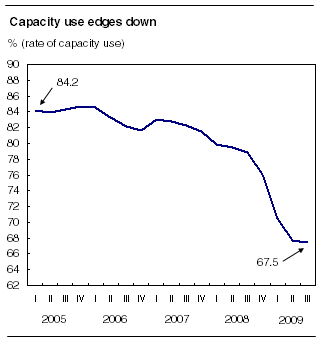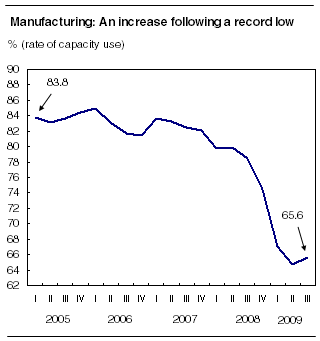Common menu bar links
Industrial capacity utilization rates
Archived Content
Information identified as archived is provided for reference, research or recordkeeping purposes. It is not subject to the Government of Canada Web Standards and has not been altered or updated since it was archived. Please "contact us" to request a format other than those available.
Canadian industries operated at 67.5% of their production capacity in the third quarter, down marginally from 67.7% in the second quarter. Widespread declines in capacity use among non-manufacturing industries more than offset increases among manufacturing industries.

In the manufacturing industries, the capacity utilization rate increased to 65.6%, from the record low of 64.7% in the second quarter.
This increase followed four quarters of decline. It was attributable in part to strength in the transportation equipment industry, where capacity utilization rose for a second straight quarter following eight consecutive quarterly declines.
Capacity use fell in all non-manufacturing sectors, but at a much slower pace than in the previous quarter. As it did in the second quarter, the mining sector led the declines.
Manufacturing: Half of the major industries post gains
Of the 21 major industries in the manufacturing sector, 11 posted gains in capacity use in the third quarter.
Three industries (transportation equipment, chemical, and wood product manufacturing) were behind the increase in capacity utilization among manufacturers. These three account for nearly one-third of total output in manufacturing. Declines in the machinery and primary metal manufacturing industries moderated the growth.

Manufacturers of motor vehicles and motor vehicle parts significantly increased their production to meet rising demand, mostly from the United States. As a result, capacity use in the transportation equipment industry increased 5.5 percentage points to 53.6% in the third quarter. Despite the two consecutive quarterly gains, the rate was still 13.2 percentage points lower than in the third quarter of 2008.
In the chemical manufacturing industry, capacity use advanced 2.7 percentage points to 72.3%. This was due largely to a 5.1% gain in production by pharmaceutical and medicine manufacturers.
Note to readers
The industrial capacity utilization rate is the ratio of an industry's actual output to its estimated potential output.
For this release, rates have been revised back to the first quarter of 2004 to reflect the revised source data.
In the wood product manufacturing industry, the utilization rate rose from 60.2% in the second quarter to 62.4% in the third, reflecting a 1.4% increase in production.
On the other hand, machinery manufacturers further reduced their capacity use by 4.2 percentage points to 60.1%. Almost all major components, including mining and oil and gas field machinery manufacturing, contributed to the 4.9% reduction in output of this industry.
Weak demand continued to drive down the utilization rate in the primary metal manufacturing industry. Primary metal manufacturers operated at 58.1% of their production capacity in the third quarter, down 3.2 percentage points. This was a much smaller decrease compared with consecutive double-digit declines in the previous three quarters.
Non-manufacturing: Moderate decline widespread across all sectors
In the non-manufacturing group, capacity use declined in all sectors in the third quarter.
In the oil and gas extraction sector, the utilization rate slipped 0.4 percentage points to 75.6%. Overall production fell in this sector, as lower activity in crude petroleum extraction more than offset increased activity in natural gas facilities.
The mining sector, excluding oil and gas extraction, operated at 48.1% of its capacity in the third quarter, down 4.6 percentage points from the second quarter and a drop of 30.2 percentage points from the third quarter of 2008. The decline in the third quarter was mainly the result of a large decrease in output at copper, nickel, lead and zinc mines as a result of temporary closures. Output in support activities for mining, and oil and gas extraction was also down.
Capacity use in the construction sector edged down from 70.5% to 69.7%, a reflection of reduced output in both residential and non-residential building construction.
In the electric power generation, transmission and distribution sector, the utilization rate fell 2.8 percentage points to 75.7%, the fourth consecutive quarterly decline. Demand for electricity fell in the third quarter.
Available on CANSIM: table 028-0002.
Definitions, data sources and methods: survey number 2821.
Data on industrial capacity utilization rates for the fourth quarter of 2009 will be released on March 11, 2010.
For more information, or to enquire about the concepts, methods or data quality of this release, contact Xiang Zhou (613-951-0457; xiang.zhou@statcan.gc.ca), Investment and Capital Stock Division.
Table 1
| Third quarter 2008r | Second quarter 2009r | Third quarter 2009 | Third quarter 2008 to third quarter 2009 | Second quarter to third quarter 2009 | |
|---|---|---|---|---|---|
| % | percentage point change | ||||
| Total industrial | 78.9 | 67.7 | 67.5 | -11.4 | -0.2 |
| Forestry and logging | 75.3 | 67.1 | 63.9 | -11.4 | -3.2 |
| Mining and oil and gas extraction | 78.2 | 68.8 | 67.0 | -11.2 | -1.8 |
| Oil and gas extraction | 78.1 | 76.0 | 75.6 | -2.5 | -0.4 |
| Mining | 78.3 | 52.7 | 48.1 | -30.2 | -4.6 |
| Electric power generation, transmission and distribution | 86.6 | 78.5 | 75.7 | -10.9 | -2.8 |
| Construction | 78.4 | 70.5 | 69.7 | -8.7 | -0.8 |
| Manufacturing | 78.5 | 64.7 | 65.6 | -12.9 | 0.9 |
| Food | 81.0 | 82.6 | 82.4 | 1.4 | -0.2 |
| Beverage and tobacco products | 69.9 | 70.5 | 70.2 | 0.3 | -0.3 |
| Beverage | 70.3 | 70.5 | 69.8 | -0.5 | -0.7 |
| Tobacco | 67.6 | 70.7 | 72.5 | 4.9 | 1.8 |
| Textile mills | 67.8 | 59.8 | 60.5 | -7.3 | 0.7 |
| Textile product mills | 80.6 | 60.0 | 58.8 | -21.8 | -1.2 |
| Clothing | 70.9 | 66.1 | 62.5 | -8.4 | -3.6 |
| Leather and allied products | 74.3 | 69.6 | 70.8 | -3.5 | 1.2 |
| Wood products | 71.8 | 60.2 | 62.4 | -9.4 | 2.2 |
| Paper | 86.4 | 73.1 | 74.3 | -12.1 | 1.2 |
| Printing and related support activities | 73.2 | 63.7 | 61.2 | -12.0 | -2.5 |
| Petroleum and coal products | 80.4 | 76.6 | 76.2 | -4.2 | -0.4 |
| Chemical | 82.3 | 69.6 | 72.3 | -10.0 | 2.7 |
| Plastics and rubber products | 75.0 | 62.0 | 63.4 | -11.6 | 1.4 |
| Plastic products | 74.3 | 61.2 | 62.6 | -11.7 | 1.4 |
| Rubber products | 78.4 | 65.9 | 67.2 | -11.2 | 1.3 |
| Non-metallic mineral products | 83.9 | 62.9 | 65.2 | -18.7 | 2.3 |
| Primary metal | 97.9 | 61.3 | 58.1 | -39.8 | -3.2 |
| Fabricated metal products | 81.0 | 63.6 | 61.3 | -19.7 | -2.3 |
| Machinery | 85.2 | 64.3 | 60.1 | -25.1 | -4.2 |
| Computer and electronic products | 87.1 | 80.7 | 82.1 | -5.0 | 1.4 |
| Electrical equipment, appliance and component | 83.0 | 72.4 | 73.9 | -9.1 | 1.5 |
| Transportation equipment | 66.8 | 48.1 | 53.6 | -13.2 | 5.5 |
| Furniture and related products | 77.3 | 66.2 | 68.1 | -9.2 | 1.9 |
| Miscellaneous manufacturing | 79.4 | 79.0 | 75.5 | -3.9 | -3.5 |

